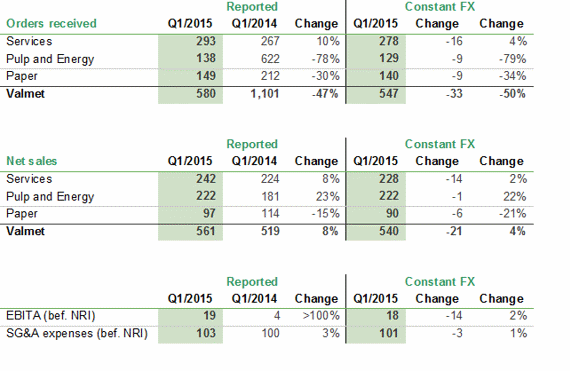Questions and answers related to Q1/2015 Interim Review
May 5, 2015
Why did the EBITA margin increase compared with Q1/2014?
We have been working hard to improve profitability and internal efficiency, for example by reducing quality costs and lead time. Volume was higher in Services and Pulp and Energy in Q1/2015 compared with Q1/2014. Also, a cost accrual of approximately EUR 10 million linked to an individual major pulp project had negative impact on the Q1/2014 result.
Why did net sales and EBITA margin decrease compared with Q4/2014?
- The timing of POC (Percentage of completion) milestones had a negative impact on net sales in the Paper business line
- In Services, net sales is typically lower in H1 than in H2 (on average, 45% of net sales in H1 and 55% in H2)
- Lower net sales impacted the EBITA margin
- Gross profit margin did, however, improve
How did the gross profit margin change compared with Q4/2014 and Q1/2014?
- Gross profit margin has improved compared with both Q4/2014 and Q1/2014 (gross profit margin was 20.1% in Q1/2015, 18.5% in Q4/2014 and 18.7% in Q1/2014)
How did changes in foreign exchange rates affect figures in Q1/2015?
- Changes in foreign exchange rates increased net sales by approximately EUR 20 million
- Changes in foreign exchange rates increased orders received in the Services business line by approximately EUR 16 million
The following table illustrates how changes in foreign exchange rates have impacted orders received, net sales, EBITA and SG&A (EUR million unless otherwise stated):

Why did orders received decline as much as 47% compared with Q1/2014?
- Orders received were exceptionally high in H1/2014 in the capital business, so it was expected that orders received declined
- Orders received increased 10% (4% in constant currencies) in the Services business line
- Large pulp orders are always lumpy and very dependent on timing
How has pricing in new orders developed?
- There has not been any changes in the pricing environment
- New orders have been sold at market prices
Selling, general and administrative (SG&A) costs increased by EUR 3 million – are the costs starting to increase?
- We expect capacity costs to remain at the same level as in 2014, excluding changes in foreign exchange rates and Automation
- Changes in foreign exchange rates increased SG&As by EUR 3 million
- Temporary layoffs were used in Q1/ 2014, which decreased SG&As in the comparison period
- We continue to focus on cost control
Based on Metso’s Q1/2015 report, the business you acquired (Process Automation Systems) was loss-making, while you have been communicating that it is a stable business. Why was it loss-making? Is the acquired business weaker than you expected?
- As Process Automation Systems (which became Valmet’s fourth business line, called Automation, as of April 1, 2015) was part of Metso in Q1/2015, we can’t comment on the development, but according to normal seasonality, Q1 is typically a weak quarter for Automation
- Based on the information we have, there is no change in the assumptions we had when we bought the Automation business, and the outlook is intact
- Automation business is stable on an annual level
Why did you upgrade the short term market outlook in pulp to “good” (from “satisfactory”)?
- We see more customer activity in the market
As you increased the short-term market outlook in pulp after the Äänekoski order, is it fair to assume that there are several other potential orders in the market?
- Äänekoski contributed to increasing the short-term market outlook
- One potential customer deal is not enough to increase the short-term market outlook
- However, the timing of orders is very difficult to forecast
Why did you downgrade the short-term market outlook in Energy to “weak” (from “satisfactory”)?
- There is more uncertainly in Energy business, partially due to rapid decline in oil price
- Customers’ decision making is slower
- It is very difficult to evaluate the impact on our business and our customers: Typically customers consider the investment in longer-term, but it may be quite difficult for them to forecast the long-term price development in this volatile environment
What are the assumptions for your guidance for 2015?
- Guidance is based on our order backlog and internal estimates for 2015